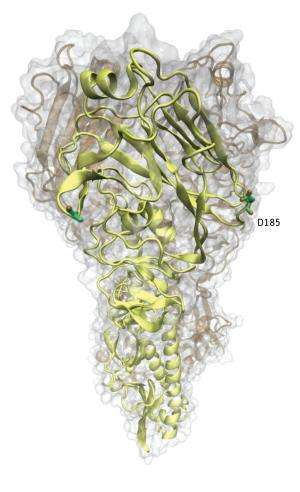Tracking a moving target

The influenza pandemic that began in Mexico in April 2009 rapidly spread throughout the world and arrived in Japan one month later. Now, a research team led by Toshihisa Ishikawa at the RIKEN Omics Science Center in Yokohama has revealed what a portion of the pandemic influenza virus looked like when it emerged in Japan (Fig. 1), and how it has changed over time. The findings will help to guide influenza vaccine development and will aid in preparations for future influenza pandemic outbreaks.
The researchers collected swab samples from the respiratory system of 253 individual flu sufferers in Osaka, Tokyo and Chiba, and sequenced the influenza genes encoding the proteins hemagglutinin (HA) and neuraminidase (NA). Although these genes represent only 10% of the influenza viral genome, they demonstrate more variability than other influenza genes, Ishikawa explains, so are likely to mediate any emerging changes in flu severity or antiviral drug resistance.
The sequencing showed that the pandemic influenza samples from the individuals in Japan fell into two groups: those that were collected at the time of the initial outbreak in May 2009, and those that were collected a few months later, during the most rapid spread of the virus throughout the country from October 2009 to January 2010.
Importantly, when the researchers compared the sequences between these two groups of viruses, they found that they fell into two totally separate clusters. This indicated that there were many differences between the two groups of pandemic influenza viruses, including the emergence of a mutation in an important site—the so-called ‘Ca antigen site’ of HA—that is known to be subject to pressure by the immune system. This mutation, as well as some others that the researchers identified, may account for the more rapid spread of the pandemic influenza virus later in the year.
Ishikawa and colleagues also found other mutations in the Ca antigen site of HA that conferred a more severe disease course, as well as mutations in NA that led to resistance to currently available antiviral drugs.
The rapid emergence of these mutations suggests that “the 2009 pandemic influenza viruses have a genome with an extremely high evolutionary rate,” says Ishikawa. Moreover, “the mutated viruses seemed to rapidly circulate around Japan via modern traffic networks,” he explains. These characteristics of the virus and its spread are important factors to consider when designing future vaccines or when deciding how best to slow any future influenza pandemic outbreaks.
More information: Morlighem, J.-É., et al. Mutation analysis of 2009 pandemic influenza A(H1N1) viruses collected in Japan during the peak phase of the pandemic. PLoS ONE 6, e18956 (2011).















